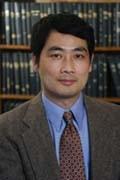
Sheng He, Ph.D.
E-MAIL: [email protected]
Research Interests:
Research in our group is centered on investigating the neural basis of human vision, visual attention, and visual awareness. Current research projects include the spatial and temporal properties of the early visual cortex, the effect of attentional modulation at different cortical sites, the nature and dynamics of binocular rivalry, pattern and motion adaptation processes. Both psychophysical and functional Magnetic Resonance Imaging methods are used in these studies.
Selected Publications:
(For a comprehensive list of recent publications, refer to PubMed, a service provided by the National Library of Medicine.)
- Zhang J, Jiang Y, Song Y, Zhang P, He S. Spatial tuning of face part representations within face-selective areas revealed by high-field fMRI. Elife. 2021 Dec 29;10:e70925.
- Ren S, Shao H, He S. Interaction between conscious and unconscious information-processing of faces and words. Neurosci Bull. 2021 Nov;37(11):1583-1594.
- Ge Y, Sun Z, Qian C, He S. Spatiotopic updating across saccades in the absence of awareness. J Vis. 2021 May 3;21(5):7.
- Ge Y, Zhou H, Qian C, Zhang P, Wang L, He S. Adaptation to feedback representation of illusory orientation produced from flash grab effect. Nat Commun. 2020 Aug 6;11(1):3925.
- Fan X, Wang F, Shao H, Zhang P, He S. The bottom-up and top-down processing of faces in the human occipitotemporal cortex. Elife. 2020 Jan 14;9:e48764.
- Cho S, He S. Size-invariant but location-specific object-viewpoint adaptation in the absence of awareness. Cognition. 2019 Aug 5;192:104035.
- Petruk V, He B, Engel S, He S. Stimulus rivalry and binocular rivalry share a common neural substrate. J Vis. 2018;18:18. doi:10.1167/18.9.18.
- Cao T, Wang L, Sun Z, Engel SA, He S. The independent and shared mechanisms of intrinsic brain dynamics: Insights from bistable perception. Front Psychol. 2018 Apr 24;9:589
- Tan Y, Tong X, Chen W, Weng X, He S, Zhao J. Vernier but not grating acuity contributes to an early stage of visual word processing. Neurosci Bull. 2018;34(3):517-526.
- Wang Y, Wang L, Xu Q, Liu D, Chen L, Troje NF, He S, Jiang Y. Heritable aspects of biological motion perception and its covariation with autistic traits. Proc Natl Acad Sci U S A. 2018;115(8):1937-1942.
- Katyal S, Vergeer M, He S, He B, Engel SA. Conflict-sensitive neurons gate interocular suppression in human visual cortex. Sci Rep. 2018 Jan 19;8(1):1239.
- Shao H, Weng X, He S. Functional organization of the face-sensitive areas in human occipital-temporal cortex. Neuroimage. 2017;157:129-143.
- Bai J, Dong X, He S, Bao M. Monocular deprivation of Fourier phase information boosts the deprived eye's dominance during interocular competition but not interocular phase combination. Neuroscience. 2017;352:122-130.
- Roy AV, Jamison KW, He S, Engel SA, He B. Deactivation in the posterior mid-cingulate cortex reflects perceptual transitions during binocular rivalry: Evidence from simultaneous EEG-fMRI. Neuroimage. 2017;152:1-11.
- Fan X, Wang L, Shao H, Kersten D, He S. Temporally flexible feedback signal to foveal cortex for peripheral object recognition. Proc Natl Acad Sci U S A. 2016;113(41):11627-11632.
- Zou J, He S, Zhang P. Binocular rivalry from invisible patterns. Proc Natl Acad Sci U S A. 2016;113(30):8408-13.
- Zhang P, Zhou H, Wen W, He S. Layer-specific response properties of the human lateral geniculate nucleus and superior colliculus. Neuroimage. 2015;111:159-166.
- Jamison KW, Roy AV, He S, Engel SA, He B. SSVEP Signatures of Binocular Rivalry During Simultaneous EEG and fMRI. J Neurosci Methods. 2015;243:53-62.
- Zhou W, Yang X, Chen K, Cai P, He S, Jiang Y. Chemosensory communication of gender through two human steroids in a sexually dimorphic manner. Curr Biol. 2014;24(10):1091-5.
Former Graduate Students:
Vadim Petruk (Ph.D. 2016, Neuroscience, University of Minnesota).
Robert Shannon (Ph.D. 2012, Neuroscience, University of Minnesota).
Patricia Costello (Ph.D. 2003, Neuroscience, University of Minnesota).
